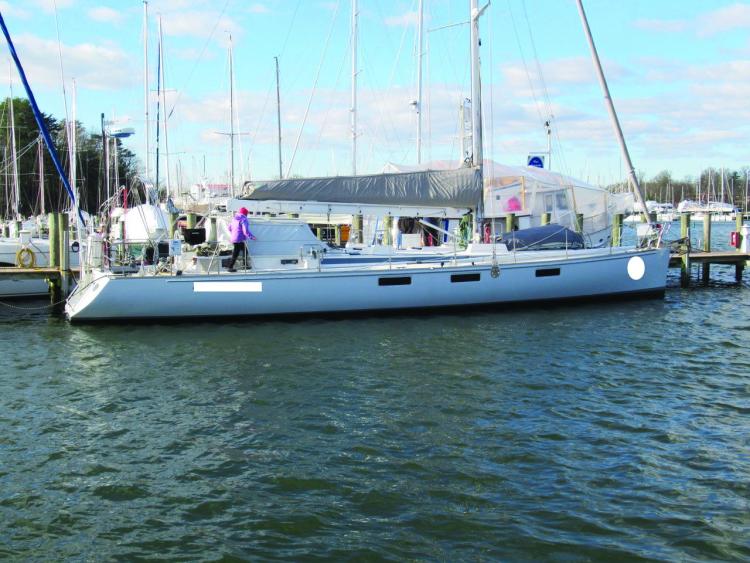A Standout Production Sailboat Model That’s Domestically Built
As we wander the docks and boat yards, we literally see thousands of fiberglass boats that after a while just blend into the landscape. Some can quickly look at a 30- to 40-foot production boat for sailing and instantly identify the make and model while most others see just another “Clorox bottle.”

Once in a while we encounter a change in the landscape such as a highly varnished classic yacht or exotic/semi-exotic performance boat that stands out from the others. These are usually not boats designed for the majority of the boating public, but are certainly fun to gawk at and drool over. One such boat that borders on the exotic but still retains some properties of the conventional production boat is the Sundeer 60. The Sundeer 60 is a limited production, domestically built performance cruiser with a narrow beam, distinctive plumb bow, and long low sheer that looks all business. Those in the know will instantly recognize the unmistakable lines of a Steve Dashew design.
Sundeer, a brief history
The Sundeer line of yachts is one in a series of narrow-beam performance cruisers designed by Naval architect Steve Dashew. Any conversation about the Sundeer series needs to review its 1980s cousin, the Deerfoot series. The first in the Deerfoot series was built in 1980, ultimately being built by several yards around the world including Europe, South Africa, and New Zealand. In 1986 the Dashews sold their interest in the Deerfoot project and went back to designing, the result being the Sundeer series. Visually, the two series are very similar. On paper there are surprising differences in draft and displacement. The Deerfoot 63 Displacement is 54,000 pounds, versus the 36,500 pounds of the Sundeer 60. The Deerfoot 63 draft is eight feet, six inches versus the six-foot draft of the Sundeer 60.
Sundeer 60
The Sundeer 60 and the Sundeer 56 are basically the same design with different lazarette dimensions, so for the purposes of this article they will be referred to jointly. The Sundeer 56/60 series was built by TPI (Tillotson Pearson) in Rhode Island. Production began in 1994 and reportedly ceased in 1997 with a total of 17 boats built; although I have personally seen a 1998 hull that was hull #18.
The distinctive feature of Deerfoots and Sundeers is the narrow beam when compared to the length. Although they were designed and built over a decade apart, the close similarities between the earlier Deerfoot series and Sundeers are unmistakable even to those who only see “Clorox bottles.” The ultimate goal of the Dashews was to design the ultimate voyaging yacht that is easily sailed by a shorthanded crew with enough speed to continuously knock out 200-mile-plus days in safety and relative comfort.
The rig on the 56/60 is a double-spreader carbon-fiber mast and boom. By some accounts the sail plan and rig are considered conservative; the powerful sail plan was designed to be handled easily by a cruising couple. The headsail was smaller than expected with the sheets actually led inboard of the shrouds. Chainplates are mounted to the hull exterior, making inspection easier and eliminating deck fittings that are notorious for causing moisture damage to deck coring and interior bulkheads.
The initial concept was to create a relatively simple boat without an overabundance of auxiliary systems. However, it has been my experience that, as the boats get older and change owners several times, the equipment list increases with the installation of generators, inverters, air conditioning, diesel heaters, high-capacity water-makers, solar panels, and wind generators.
The engine is a reliable 87-horsepower Yanmar with a straight shaft drive via a Kanzaki transmission. This drive train is both extremely reliable and has an extremely broad worldwide service network.
In keeping with TPI construction methods, the hulls and decks are built with Balsa core both above and below the water line. The Sundeers were built using SCRIMP (Seamans Composites Resin Infusion Molding Process), which is (arguably) an improvement over earlier open-mold hand-lay-up methods, resulting in a more uniform and measured distribution of resin within the fiberglass laminates and balsa core.
The hulls were laminated with vinyl ester resin for increased protection against osmosis.
The forward portion of the hull is advertised as a water-tight collision bulkhead.
Findings and observations:
Unfortunately, one of the properties that the Sundeers seemed to have inherited from TPI is the potential for crazing of the gelcoat on some or all exterior gelcoat surfaces including the hull sides, below the water line, and in the deck. To be fair the crazing is not unique to the Sundeers but is a problem that has plagued many TPI models and other makes of similar age such as Sabre.
Despite the use of vinyl ester resins, I have seen evidence of osmotic blistering in the hulls.
These boats are purpose built and designed for long ocean passages and circumnavigations; as a result these boats tend to accumulate high engine and generator hours.
As with many world cruisers, the AC electrical systems have frequently been adapted for use with European power grids. The numerous approaches to this challenge have the potential of adding to the complexity of the shore power systems.
Marketplace:
As of April 2021, there was only one Deerfoot on the market at $498,000.
About the Author: Capt. Tarn Kelsey owns and operates Kelsey Marine Survey in Annapolis.




